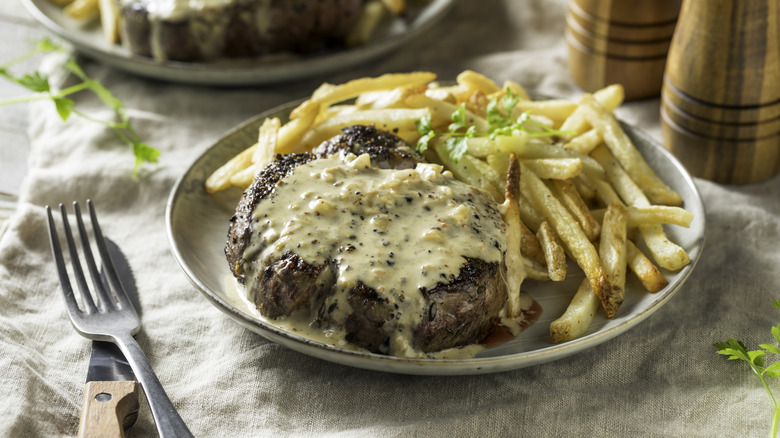Anthony Bourdain Considered One French Cut Of Steak 'Poor Man's Filet'
Anthony Bourdain was a chef, a travel documentarian, and an accomplished author, but above all things, he was a man of the people. Equally as at home eating his favorite pastrami sandwich as a Michelin-starred meal, Bourdain clearly took great pride in making high-quality food accessible to those not already in the know. One such example is his effort to bring high-quality, lower-cost steak to the masses in the form of filet de romsteck, otherwise known as faux-filet.
"The elusive filet de romsteck [is] a cylindrical column of beef about a foot long, a tasty, fairly tender, and completely trimmed hunk that resembles filet mignon," Bourdain wrote in an article for the New York Times in July 2000. This lesser-known cut is carved from the larger coeur de romsteck, which is generally considered the cheapest cut from the rump. From there, it's divided into thick, delicious steaks known as pavé de romsteck. The meat is marbled and rich, and it cooks into a tender, soft bite reminiscent of your favorite tenderloin.
Given its relative anonymity in the United States, you may not be able to walk into a grocery store and walk out with a pavé de romsteck. But according to Bourdain, this cut may be available at a local butcher, especially if they're French and you give them some advance notice.
How to cook a faux-filet, Bourdain style
When it comes to cooking your faux-filet, Anthony Bourdain calls for a simple cracked peppercorn seasoning before searing in a pan, making sure not to flambé the steak. If the thick cut isn't cooked through, you can finish it in the oven. For a final sauce, discard the excess grease from the pan and deglaze it with brandy . "As the brandy reduces ... add a few ounces of demiglace (you can buy it frozen if you must), a pinch more of crushed black pepper, some sea salt, and reduce a little more," Bourdain recommended. "At the very end, gently swirl in a heart-clogging hunk of butter until the sauce becomes a creamy emulsion."
You can also try your hand at the classic steak au poivre, which follows a similar recipe but adds shallots, Dijon mustard, crème fraîche, and lemon juice to the finishing sauce. The result is a rich, nuanced compliment to your succulent steak. This dish is a bistro classic and is often served with a bed of fries.
At his restaurant Les Halles, Bourdain served faux-filet with beurre rouge, or red wine butter. To make this delicious sauce, boil down a ½ cup of red wine with shallots until the alcohol is almost completely gone but the veggies haven't burned. Afterward, add what remains to two sticks of softened butter with parsley, salt, and pepper. Then use plastic wrap to divide the combination into 1-inch logs that can be stored in the fridge or freezer.


